Others
Mt. Takao has abundant nature with warm-temperature forests and temperate forests. There are a lot more species could be called as "treasure" inhabits other than explained in animals, insects and birds section. Spiders is one of them because they are beneficial insects and its prey is destructive insects. Over 300 species including rare ones inhabits and Mt. Takao is the mountain with the largest number of species of spiders and widely known as a paradise for spiders.
-
高尾山の水辺が育む生命たち

 高尾山の水辺が育む生命たち
高尾山の水辺が育む生命たち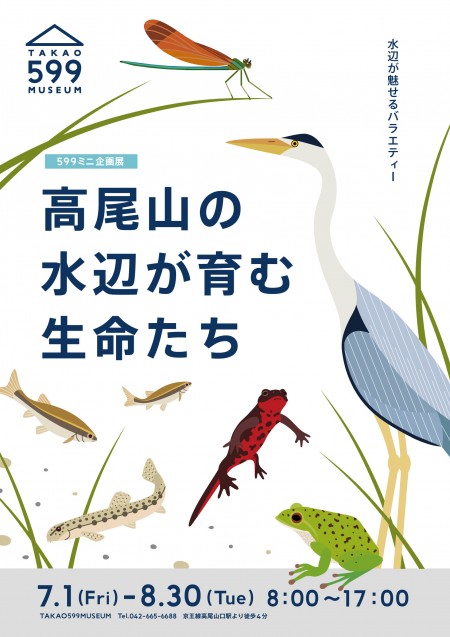 2022年7月1日~2022年8月30日「高尾山の水辺が育む生命たち」
2022年7月1日~2022年8月30日「高尾山の水辺が育む生命たち」
高尾山には川・池・沢・田んぼといった様々な水辺環境があります。それらの水辺では多くの生き物たちが暮らしています。本展示ではトンボや魚、カエルや水鳥などについてご紹介しています。
※パネルの内容は展示当時の情報となり、最新の情報とは異なる場合があります。 -
Plestiodon finitimus Scincidae
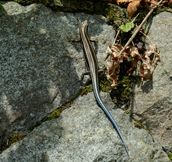
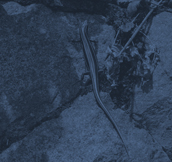 Plestiodon finitimus Scincidae
Plestiodon finitimus Scincidae They inhabit in eastern Japan Hosyu area from Kyoto to Wakayama except for Hokkaido and Izu Peninsula.
They inhabit in eastern Japan Hosyu area from Kyoto to Wakayama except for Hokkaido and Izu Peninsula.
It was thought that they used to be the same species as Plestiodon japnicus which inhabits in western Japan, but that they turned out to be the different species in 2012,and thus the name of Plestiodon japonicus was given to the one that inhabit in eastern Japan (The name of the one for the western Japan is the same, not changed).
They dwell at the grasslands and the mountain forest from low altitudes to high land, and we can often see them sunbathe on the ground of the mountain trail and on a sunny slope at Mt. Takao.
The body is tinged with glowing brownish yellow, and smooth body surface to touch.
They have as 1.5 long a tail as their head trunk. Larva has a black body and a tail tinged with metallic blue, which makes them stand out well.
They are quick in move and very cautious, so that when they see figures of people they immediately run into within the shadows. Nevertheless, when caught by the enemies they can cut their tail themselves to run, which is called ‘Jigiri’ (cutting oneself by a part of their body).
The eat baits such as small insects, spiders, and Porcellio scaber.
In June they lay eggs and a female parent incubates eggs.
●Size about 15 to 25 cm
●Season about April to October -
Takydromus tachydromoides (Japanese Grass Lizard) Lacertidae
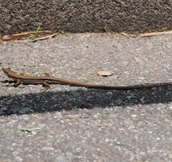
 Takydromus tachydromoides (Japanese Grass Lizard) Lacertidae
Takydromus tachydromoides (Japanese Grass Lizard) Lacertidae Main region: Hokkaido, Honshu, Shikoku, Kyushu, Yaku Island, Tanega Island and Nakanoshima Island. Found in grasslands and shrubs from flatlands to low elevations and also around residential areas and often see them sunbathing on rock fences and rocks at gardens. The Japanese name Nihon-kana-hebi literally meaning Japanese cute snakes but they are a group of lizards, not snakes. The biggest difference from Japanese five-lined skink is to have rough surfaced scales. Are active during daytime and sleep on fallen leaves or grass at night. Are predators and feed on spiders and porcellio scabers. Have distinct long tails and the length is twice as long as the length of head to body. Are able to cut own tails to protect itself from enemies. The body color is brown from back to side of abdomen and white on abdomen. Have one white line from under the eye to the side of abdomen.
Main region: Hokkaido, Honshu, Shikoku, Kyushu, Yaku Island, Tanega Island and Nakanoshima Island. Found in grasslands and shrubs from flatlands to low elevations and also around residential areas and often see them sunbathing on rock fences and rocks at gardens. The Japanese name Nihon-kana-hebi literally meaning Japanese cute snakes but they are a group of lizards, not snakes. The biggest difference from Japanese five-lined skink is to have rough surfaced scales. Are active during daytime and sleep on fallen leaves or grass at night. Are predators and feed on spiders and porcellio scabers. Have distinct long tails and the length is twice as long as the length of head to body. Are able to cut own tails to protect itself from enemies. The body color is brown from back to side of abdomen and white on abdomen. Have one white line from under the eye to the side of abdomen.
●Body Length about 16 to 27 cm
●Season April to October -
Elaphe climacophora (Japanese Rat Snake) Colubridae
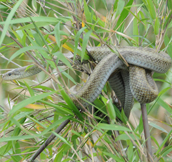
 Elaphe climacophora (Japanese Rat Snake) Colubridae
Elaphe climacophora (Japanese Rat Snake) Colubridae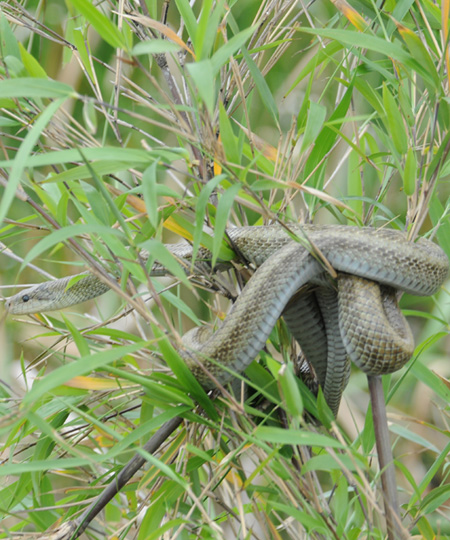 Main region: Hokkaido to Kyushu, Kunashiri Island, Sado Island and Goto Islands. Found in forests and grasslands from flatlands to mountains and also in ceilings. Most commonly known snake in Honshu. The body color is brownish olive but varies by individual species. The body size of large species is more than 2 meters but they are calm and not poisonous. Are good at climbing up trees by using keeled scales, even vertical trees or power poles and hunt for baby birds or eggs in bird’s nests. The white species called shirohebi literally meaning white snakes are the albino species of this species. This white rat snakes live in Iwakuni city of Yamaguchi prefectures and are designated as protected species.
Main region: Hokkaido to Kyushu, Kunashiri Island, Sado Island and Goto Islands. Found in forests and grasslands from flatlands to mountains and also in ceilings. Most commonly known snake in Honshu. The body color is brownish olive but varies by individual species. The body size of large species is more than 2 meters but they are calm and not poisonous. Are good at climbing up trees by using keeled scales, even vertical trees or power poles and hunt for baby birds or eggs in bird’s nests. The white species called shirohebi literally meaning white snakes are the albino species of this species. This white rat snakes live in Iwakuni city of Yamaguchi prefectures and are designated as protected species.
●Body Length about 100 to 200 cm
●Season April to October -
Elaphe quadrivirgata (Japanese Striped Snake) Colubridae

 Elaphe quadrivirgata (Japanese Striped Snake) Colubridae
Elaphe quadrivirgata (Japanese Striped Snake) Colubridae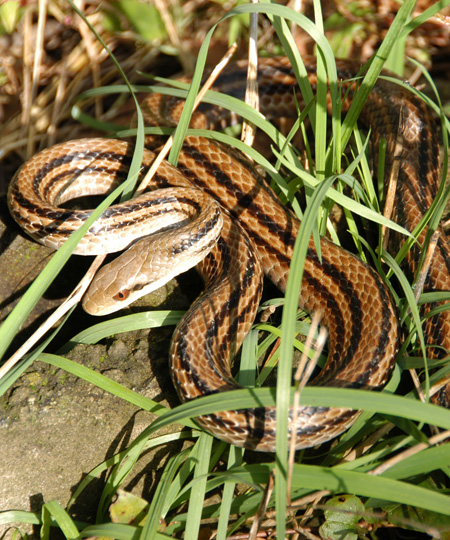 Main region: Hokkaido, Honshu, Shikoku, Kunashiri Island, Sado Island and Osumi Islands. Found in sunny croplands, riverbeds and grasslands from flatlands to mountains as they often bath in the sun. Are commonly known snakes like Japanese forest ratsnake and tiger keelback. Body patterns vary by individual species but most of them have four black stripes as the Japanese name Shima-hebi literally meaning stripe snake states. Some species have black body and called karasu-hebi literally meaning crow snake. Are active during daytime and hunt for frogs, rats, lizards, salamanders and eggs of birds. Also have a habit to eat another snakes such as Japanese forest ratsnake and amphiesma vibakari. When sensing dangers, threat others by making S shape with body.
Main region: Hokkaido, Honshu, Shikoku, Kunashiri Island, Sado Island and Osumi Islands. Found in sunny croplands, riverbeds and grasslands from flatlands to mountains as they often bath in the sun. Are commonly known snakes like Japanese forest ratsnake and tiger keelback. Body patterns vary by individual species but most of them have four black stripes as the Japanese name Shima-hebi literally meaning stripe snake states. Some species have black body and called karasu-hebi literally meaning crow snake. Are active during daytime and hunt for frogs, rats, lizards, salamanders and eggs of birds. Also have a habit to eat another snakes such as Japanese forest ratsnake and amphiesma vibakari. When sensing dangers, threat others by making S shape with body.
●Body Length about 80 to 200 cm
●Season April to about October -
Elaphe conspicillata (Japanese Forest Ratsnake) Colubridae
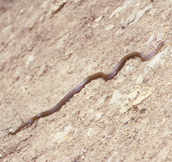
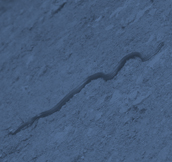 Elaphe conspicillata (Japanese Forest Ratsnake) Colubridae
Elaphe conspicillata (Japanese Forest Ratsnake) Colubridae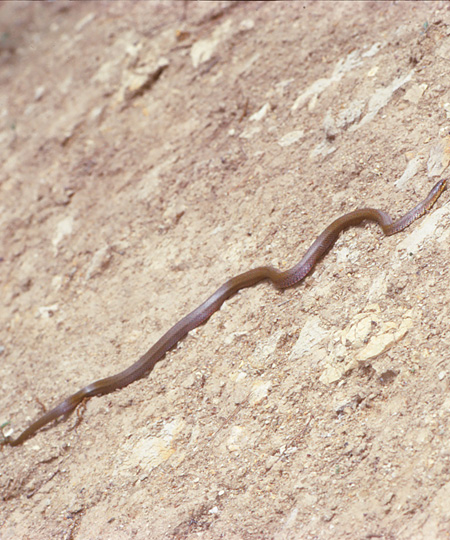 Main region: Hokkaido, Honshu, Shikoku, Kyushu, Kunashiri Island, Izu Islands and Tanega Island. Found in croplands and grasslands in flatlands but mainly in forests of low elevations. Have small head and does not have skinny neck that is suitable for living underground as the Japanese name Jimuguri literally meaning to live underground states. Feed on rat live underground and small moles. Hunt these preys by searching their nest tunnels and sneaking inside the nests. Are calm and not poisonous and does not bite. Only bite when they are sensing dangers like human beings trying to touch their body. Sometimes release grass-like smelled secretions from anal glands. Go dormant in winter but often stay underground even in summer as they are not so bearable in hot weather.
Main region: Hokkaido, Honshu, Shikoku, Kyushu, Kunashiri Island, Izu Islands and Tanega Island. Found in croplands and grasslands in flatlands but mainly in forests of low elevations. Have small head and does not have skinny neck that is suitable for living underground as the Japanese name Jimuguri literally meaning to live underground states. Feed on rat live underground and small moles. Hunt these preys by searching their nest tunnels and sneaking inside the nests. Are calm and not poisonous and does not bite. Only bite when they are sensing dangers like human beings trying to touch their body. Sometimes release grass-like smelled secretions from anal glands. Go dormant in winter but often stay underground even in summer as they are not so bearable in hot weather.
●Body Length about 70 to 100 cm
●Season April to October -
Amphiesma vibakari vibakari (Japanese Keelback) Colubridae
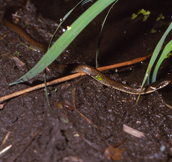
 Amphiesma vibakari vibakari (Japanese Keelback) Colubridae
Amphiesma vibakari vibakari (Japanese Keelback) Colubridae Main region: Honshu, Shikoku, Kyushu, Sado Island and Iki Island, Oki Island and Goto Islands. Small snake found in wide varieties of areas including forests, grasslands, paddy fields and croplands. The Japanese name Hibakari came from its literally meaning to be bitten or live only a day, however they are not poisonous and does not bite because they are very calm. When sensing dangers, threat others by making S shape with body. Are active on the ground but mostly stay underwater as they are good at swimming compare to other snakes. Feed on waterside species including small frogs or tadpoles and even hunt for fishes in water such as loaches.
Main region: Honshu, Shikoku, Kyushu, Sado Island and Iki Island, Oki Island and Goto Islands. Small snake found in wide varieties of areas including forests, grasslands, paddy fields and croplands. The Japanese name Hibakari came from its literally meaning to be bitten or live only a day, however they are not poisonous and does not bite because they are very calm. When sensing dangers, threat others by making S shape with body. Are active on the ground but mostly stay underwater as they are good at swimming compare to other snakes. Feed on waterside species including small frogs or tadpoles and even hunt for fishes in water such as loaches.
●Body Length about 40 to65 cm
●Season April to October -
Rhabdophis tigrinus (Tiger Keelback) Colubridae

 Rhabdophis tigrinus (Tiger Keelback) Colubridae
Rhabdophis tigrinus (Tiger Keelback) Colubridae Main region: Honshu, Shikoku, Kyushu, Sado Islands, Goto Islands, Yaku Island and Tanega Island. Found in flatlands to low elevations and prefer paddy fields and swampy areas. Feed on frogs, lizards and fish but prefer frogs the best. This species is large in body size and even feed on toads which most of other snakes does not. Are not harmful to human beings compare to habu and pit viper but it is dangerous to be bitten because there are poisonous fangs deep inside of mouth. The poison causes death depending on the condition of human body. Also have poison in glands at the back of neck. It is dangerous even to step on them because the skin of poisonous glands will break and poisonous secretion will splash. Normally stay calm and does not bite unless human beings try to touch or catch them.
Main region: Honshu, Shikoku, Kyushu, Sado Islands, Goto Islands, Yaku Island and Tanega Island. Found in flatlands to low elevations and prefer paddy fields and swampy areas. Feed on frogs, lizards and fish but prefer frogs the best. This species is large in body size and even feed on toads which most of other snakes does not. Are not harmful to human beings compare to habu and pit viper but it is dangerous to be bitten because there are poisonous fangs deep inside of mouth. The poison causes death depending on the condition of human body. Also have poison in glands at the back of neck. It is dangerous even to step on them because the skin of poisonous glands will break and poisonous secretion will splash. Normally stay calm and does not bite unless human beings try to touch or catch them.
●Body Length about 70 to 150 cm
●Season April to October -
Gloydius blomhoffii Viperinae
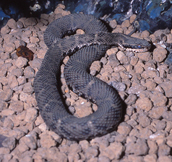
 Gloydius blomhoffii Viperinae
Gloydius blomhoffii Viperinae They live widely in Hokkaido, main land Honsyu, Shikoku, Kyusyu as well as Osumi-shoto Islands and Izu Peninsula.
They live widely in Hokkaido, main land Honsyu, Shikoku, Kyusyu as well as Osumi-shoto Islands and Izu Peninsula.
Mainly they inhabit in the bushes along the mountain streams at low lands, in the forest, and woods in the mountain district, but we sometimes see them in arable land.
They are very notorious poisonous snake, and there are so many incidental deaths that people die.
Their body is tinged with pale dark brown as base, usually have elliptically-shaped mottles with black mottles in their center in line, while some tinged with strong red, some entirely in black.
There are varietas. Basically, they are nocturnal animal, around the time when temperatures were much lower, they are active even during the daytime.
We sometimes see them at Mt. Takao, we, ordinary mountain climbers hardly come across them if we walk within the specified Trail rout areas.
If we happen to encounter them, keep our hands off, keep ourselves away 1m away, and let them pass, they do not attack us.
Their main bait is such small animals and insects as rats, lizards, and frogs.
They can use a sense of vision and a sense of smell as well as an organ called ‘a pit’ near the nose to detect infrared-ray to find baits.
They are an ovoviviparous animal (Rantaisei: a female spider hatches the eggs inside their own body, and then lays them as baby spiders), lay about 10 baby spiders from the end of the summer till he autumn.
Size about 45 to 60 cm
Season April to October -
Hynobius tokyoensis (Tokyo Salamander) Hynobiidae
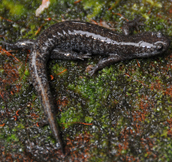
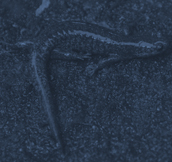 Hynobius tokyoensis (Tokyo Salamander) Hynobiidae
Hynobius tokyoensis (Tokyo Salamander) Hynobiidae Main region: Kanto area (except Gunma prefecture) and some parts of Fukushima prefecture. Found in forests on hills and waterside in mountains and mostly live on the ground except breeding season. The baby is like the small version of axolotl and live mostly underwater. Feed on insects live on the ground including earthworms, porcellio scabers, spiders and wood louses. The body color varies by individual species but mostly dark-brown with black spots on entire body. Are active at night and it is difficult to find during daytime as they are normally hide alone underground and under rocks. In autumn, become even more active to hunt for preys in order to prepare for going dormant in winter and breeding. The breeding season is from February to March and often found in water with no flow including ponds or ditches of paddy fields.
Main region: Kanto area (except Gunma prefecture) and some parts of Fukushima prefecture. Found in forests on hills and waterside in mountains and mostly live on the ground except breeding season. The baby is like the small version of axolotl and live mostly underwater. Feed on insects live on the ground including earthworms, porcellio scabers, spiders and wood louses. The body color varies by individual species but mostly dark-brown with black spots on entire body. Are active at night and it is difficult to find during daytime as they are normally hide alone underground and under rocks. In autumn, become even more active to hunt for preys in order to prepare for going dormant in winter and breeding. The breeding season is from February to March and often found in water with no flow including ponds or ditches of paddy fields.
●Body Length about 8 to 13 cm
●Season April to October -
Hynobius kimurae (Hida Salamander) Hynobiidae

 Hynobius kimurae (Hida Salamander) Hynobiidae
Hynobius kimurae (Hida Salamander) Hynobiidae Main region: Kanto area, Chubu area, Hokuriku area, Kinki area and Chugoku area. Found in appropriate humid areas of valleys and streamside in mountain forests. The body color is purple-brown with yellow spots like sprinkles gold leaf. Are active at night and daytime of rainy days. Are mostly rest under the rocks and fallen leaves and become active after dark and hunt for earthworms, slugs, spiders and small insects. Adults mostly live on the ground but move to waterside to lay eggs during breeding season. Lay eggs in upstream of streams with moderate water flow and lay eggs in egg sac on the rocky ground. Egg sac is bluish fluorescent color.
Main region: Kanto area, Chubu area, Hokuriku area, Kinki area and Chugoku area. Found in appropriate humid areas of valleys and streamside in mountain forests. The body color is purple-brown with yellow spots like sprinkles gold leaf. Are active at night and daytime of rainy days. Are mostly rest under the rocks and fallen leaves and become active after dark and hunt for earthworms, slugs, spiders and small insects. Adults mostly live on the ground but move to waterside to lay eggs during breeding season. Lay eggs in upstream of streams with moderate water flow and lay eggs in egg sac on the rocky ground. Egg sac is bluish fluorescent color.
●Body Length about 10 to18 cm
●Season All year -
Bufo japonicus formosus (Eastern-Japanese Common Toad) Bufonidae
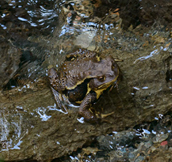
 Bufo japonicus formosus (Eastern-Japanese Common Toad) Bufonidae
Bufo japonicus formosus (Eastern-Japanese Common Toad) Bufonidae Main region: Some parts of Hokkaido (man-induced distribution), Honshu (from Tohoku region to Kinki region on Japan Sea side, North of Sanin area and some part of Kii peninsula). Found in forests from flatlands to mountains and also in temples or residence. Are widely known as “gama” from ancient time. The body size varies by living region, smaller in cold climate area like Tohoku region and become larger in warm climate. The body color also varies by regions but most of them are brown but some are reddish or yellowish. Hardly ever jump and just walk. Are predators and feed on insects, spiders and earthworms. The white secretions from the protrusions on the back are poisonous.
Main region: Some parts of Hokkaido (man-induced distribution), Honshu (from Tohoku region to Kinki region on Japan Sea side, North of Sanin area and some part of Kii peninsula). Found in forests from flatlands to mountains and also in temples or residence. Are widely known as “gama” from ancient time. The body size varies by living region, smaller in cold climate area like Tohoku region and become larger in warm climate. The body color also varies by regions but most of them are brown but some are reddish or yellowish. Hardly ever jump and just walk. Are predators and feed on insects, spiders and earthworms. The white secretions from the protrusions on the back are poisonous.
●Body Length about 9 to 17cm
●Season April to October -
Rana ornativentris (Montane Brown Frog) Ranidae
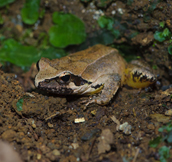
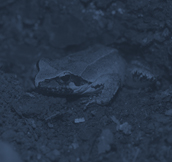 Rana ornativentris (Montane Brown Frog) Ranidae
Rana ornativentris (Montane Brown Frog) Ranidae Main region: Honshu, Shikoku, Kyushu and Sado Island. Found in paddy fields, ponds and swamps in flatlands to forests up to 1,000 meters elevations. Is commonly known frogs. The body color varies by individual species but mostly reddish as the Japanese name Yama-aka-gaeru literally meaning red frog in mountains. Are red-brown to dark-brown on the back and light red to orange from side of abdomen, fore legs and thigh. Feed on earthworms, slugs and small insects. The way they go dormant is quite unique. Some do live underground just like other frogs do but some hide under the ground in water and spend throughout winter in water.
Main region: Honshu, Shikoku, Kyushu and Sado Island. Found in paddy fields, ponds and swamps in flatlands to forests up to 1,000 meters elevations. Is commonly known frogs. The body color varies by individual species but mostly reddish as the Japanese name Yama-aka-gaeru literally meaning red frog in mountains. Are red-brown to dark-brown on the back and light red to orange from side of abdomen, fore legs and thigh. Feed on earthworms, slugs and small insects. The way they go dormant is quite unique. Some do live underground just like other frogs do but some hide under the ground in water and spend throughout winter in water.
●Body Length about 4 to 8 cm
●Season March to October -
Rana tagoi tagoi (Tago’s Brown Frog) Ranidae
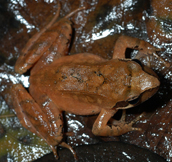
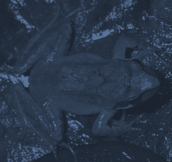 Rana tagoi tagoi (Tago’s Brown Frog) Ranidae
Rana tagoi tagoi (Tago’s Brown Frog) Ranidae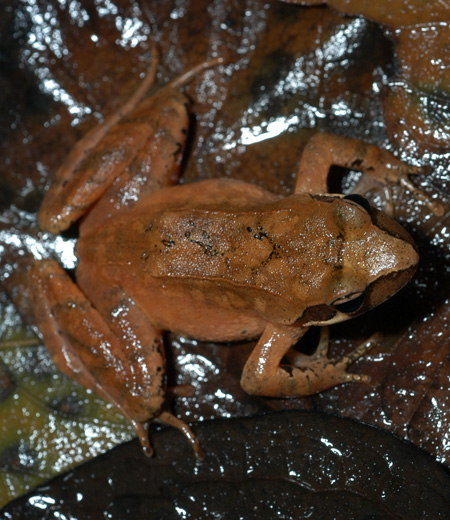 Main region: Honshu, Shikoku, Kyushu and Goto Islands. Found in forests and streams in mountains. The body color varies by individual species from ocher to red-brown. Feed on insects, spiders and shellfish that mostly live on the ground. Male have vocal sac (sound-resonating throat pouch) and create unique voice with low tones during breeding season but it is difficult to find them as they are mostly hiding between rocks as they are small species. Breeding season is from February to March, and lay larger sized eggs compare to other frogs. Hatched tadpoles live from nutrients from eggs and live on the ground after emerged to adults. It was named after famous herpetologist Prof. Katsuya Tago.
Main region: Honshu, Shikoku, Kyushu and Goto Islands. Found in forests and streams in mountains. The body color varies by individual species from ocher to red-brown. Feed on insects, spiders and shellfish that mostly live on the ground. Male have vocal sac (sound-resonating throat pouch) and create unique voice with low tones during breeding season but it is difficult to find them as they are mostly hiding between rocks as they are small species. Breeding season is from February to March, and lay larger sized eggs compare to other frogs. Hatched tadpoles live from nutrients from eggs and live on the ground after emerged to adults. It was named after famous herpetologist Prof. Katsuya Tago.
●Body Length about 3 to 5 cm
●Season March to October -
Buergeria buergeri (Kajika Frog) Rhacophoridae

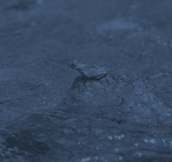 Buergeria buergeri (Kajika Frog) Rhacophoridae
Buergeria buergeri (Kajika Frog) Rhacophoridae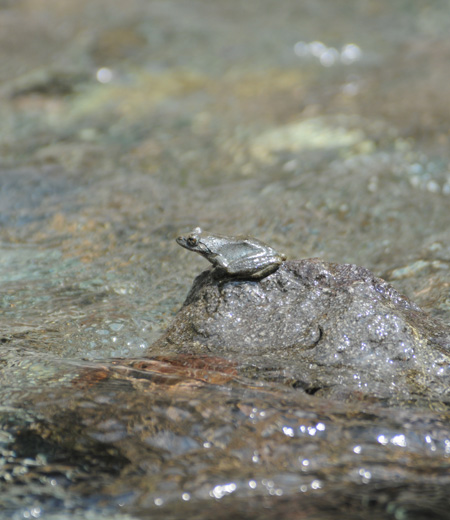 Main region: Honshu, Shikoku, Kyushu and Goto Islands. Found in up-stream to mid-stream and surrounding forests. The body color is gray to brown with dark spots patterns. It becomes the protecting color and is hard to find them especially when rested on rocks in rivers. The beautiful voice has been loved by people from ancient times, and makes “fi fi fi fi fi” sounds. This resembles the voice of deer, hence the Japanese name Kajika-gaeru literally meaning deer frogs. It was farmed many in Edo period and the tool called Kajika basket to foster them. The body size differs by genders, female is twice as large as male.
Main region: Honshu, Shikoku, Kyushu and Goto Islands. Found in up-stream to mid-stream and surrounding forests. The body color is gray to brown with dark spots patterns. It becomes the protecting color and is hard to find them especially when rested on rocks in rivers. The beautiful voice has been loved by people from ancient times, and makes “fi fi fi fi fi” sounds. This resembles the voice of deer, hence the Japanese name Kajika-gaeru literally meaning deer frogs. It was farmed many in Edo period and the tool called Kajika basket to foster them. The body size differs by genders, female is twice as large as male.
●Body Length about 5 to 7 cm
●Season April to October -
Rhacophorus arboreus Rhacophoridae
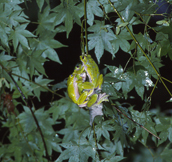
 Rhacophorus arboreus Rhacophoridae
Rhacophorus arboreus Rhacophoridae They live widely in Hokkaido, main land Honsyu, Shikoku, Kyusyu as well as Osumi-shoto Islands and Izu Peninsula.
They live widely in Hokkaido, main land Honsyu, Shikoku, Kyusyu as well as Osumi-shoto Islands and Izu Peninsula.
As their name show it, they inhabit in the woodland, adults dwell almost on the trees. On occasion, they live in the forests of Buddhist temples and Shinto shrines with ponds, they are designated as a protected species in many inhabitant places.
Some are tinged with green with the back in dark green. Some are tinged with green with the red-brown patterns.
They resemble Rhacophorus schlegelii, but Rhacophorus arboreus has larger bodies and the red color around eyes, which is how to distinguish the two.
A male’s chirp sounds like ‘KO-KO-KO’ or ‘KA-KA-KA’.
From late April to July, 1 female and several males lay eggs on the branches that protrude over the water.
These eggs are wrapped within meringue-like smother.
The eggs incubate in 7 – 10 days to change into tadpole, and fall into the water.
Size Male: about 40 to 60 cm, Female: about 50 to 75 cm
Season April to about October -
Rhacophorus schlegelii (Schlegel’s Green Tree Frog) Rhacophoridae
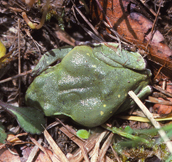
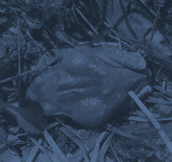 Rhacophorus schlegelii (Schlegel’s Green Tree Frog) Rhacophoridae
Rhacophorus schlegelii (Schlegel’s Green Tree Frog) Rhacophoridae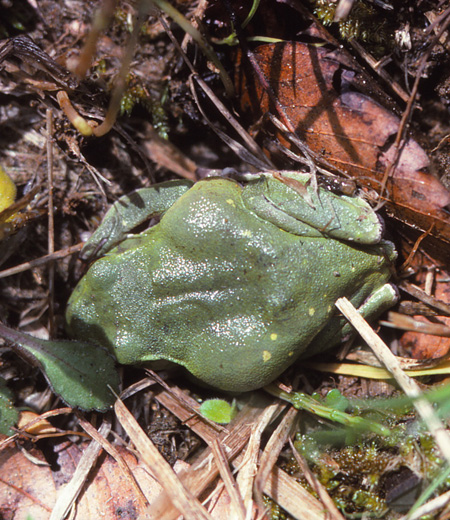 Main region: Honshu, Shikoku, Kyushu and Goto Islands. Found in swamps and waterside especially at paddy fields from flatlands to hills. The unique name was named after German zoologist Prof. Hermann Schlegel who was the chief of National Museum of Natural History in Leiden, Netherlands. The body color is bright yellow-green except abdomen. Have sharp face without black line is to identify this species from similar Japanese tree frog. Hunt for spiders and centipedes. Most frogs lay eggs in water but this species dig holes near water and lay eggs in soils. Eggs are covered with meringue-like bubbles and hatched eggs can be flown to water with rain
Main region: Honshu, Shikoku, Kyushu and Goto Islands. Found in swamps and waterside especially at paddy fields from flatlands to hills. The unique name was named after German zoologist Prof. Hermann Schlegel who was the chief of National Museum of Natural History in Leiden, Netherlands. The body color is bright yellow-green except abdomen. Have sharp face without black line is to identify this species from similar Japanese tree frog. Hunt for spiders and centipedes. Most frogs lay eggs in water but this species dig holes near water and lay eggs in soils. Eggs are covered with meringue-like bubbles and hatched eggs can be flown to water with rain
●Body Length about 3 to 5 cm
●Season April to October -
Hyla japonica (Japanese Tree Frog) Hylidae

 Hyla japonica (Japanese Tree Frog) Hylidae
Hyla japonica (Japanese Tree Frog) Hylidae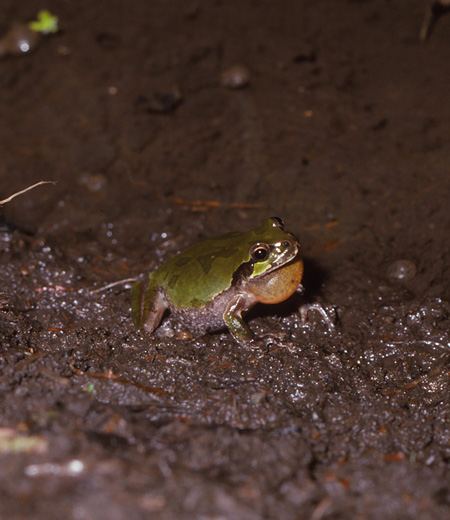 Main region: All over Japan and southernmost area is Yaku Island. Is the most popular and widely distributed in Japan. Found in waterside from flatlands to mountains. Most people may have seen them at least once in paddy fields. Are bright green on the back but could turn them into brown or gray-brown adjusted to the surrounding environment. Make “croak, croak, croak…” sounds by enlarging vocal sacs like balloons. Feed on insects and spiders. They are cute looking and make people want to touch but their skin is poisonous. Cause pain when rubbing eyes with the hand touched their skin (This is common in amphibia species). Eyes of tadpoles are apart, thus it is easy to identify this species from other frog’s tadpoles.
Main region: All over Japan and southernmost area is Yaku Island. Is the most popular and widely distributed in Japan. Found in waterside from flatlands to mountains. Most people may have seen them at least once in paddy fields. Are bright green on the back but could turn them into brown or gray-brown adjusted to the surrounding environment. Make “croak, croak, croak…” sounds by enlarging vocal sacs like balloons. Feed on insects and spiders. They are cute looking and make people want to touch but their skin is poisonous. Cause pain when rubbing eyes with the hand touched their skin (This is common in amphibia species). Eyes of tadpoles are apart, thus it is easy to identify this species from other frog’s tadpoles.
●Body Length about 3 to 4 cm
●Season April to October -
Tribolodon hakonensis (Japanese Dace) Cyprinidae
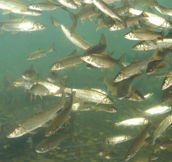
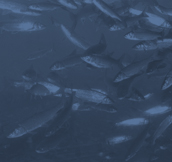 Tribolodon hakonensis (Japanese Dace) Cyprinidae
Tribolodon hakonensis (Japanese Dace) Cyprinidae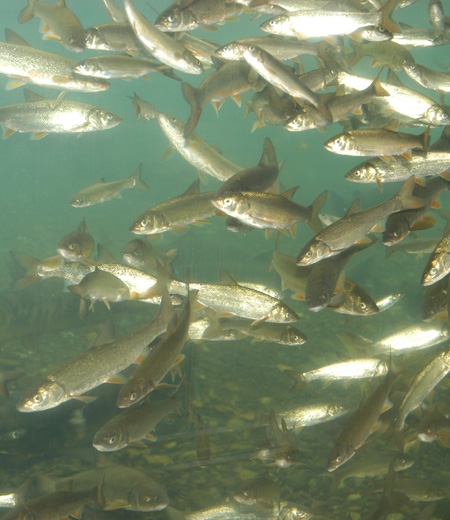 Main region: Hokkaido to Kyushu. Found in wide range of areas from upstream to the mouth of the river, lakes and ponds. Also live in water with high acidity level where most of fish cannot live. Some live in fresh water and some are sea-run variety. Also have other names depends on region like Akahara or Ida but Haya is the name often called in Tokyo area. Are omnivorous and feed on insects in water, moss on water floor and fish eggs. The body color turns to beautiful bright red with black stripes during breeding season.
Main region: Hokkaido to Kyushu. Found in wide range of areas from upstream to the mouth of the river, lakes and ponds. Also live in water with high acidity level where most of fish cannot live. Some live in fresh water and some are sea-run variety. Also have other names depends on region like Akahara or Ida but Haya is the name often called in Tokyo area. Are omnivorous and feed on insects in water, moss on water floor and fish eggs. The body color turns to beautiful bright red with black stripes during breeding season.
●Body Length about 30 cm
●Season All year -
Oncorhynchus masou masou (Seema) Salmonidae

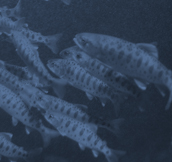 Oncorhynchus masou masou (Seema) Salmonidae
Oncorhynchus masou masou (Seema) Salmonidae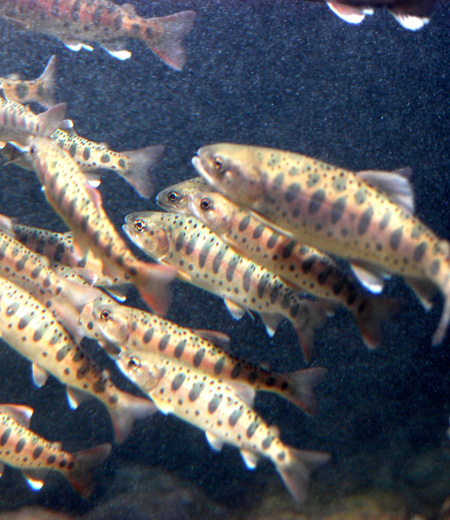 The Japanese name Yamame is not this species’ name but all species in seema that remain in rivers and not travel to the sea. Main region is Hokkaido, Honshu (north of Kanagawa prefecture), Shikoku (except Seto Inland Sea) and some part of Kyushu. Found in fresh upstream which water temperature is below 20 degrees. Feed on insects fallen to rivers, shellfish and fish. Have six to twelve large spots-like patterns (called parr mark) and have reddish center. Are also called as the queen of streams because of their beautiful body patterns. Similar red spotted masu trout also remain in rivers and have bright red parr marks that are different from this species.
The Japanese name Yamame is not this species’ name but all species in seema that remain in rivers and not travel to the sea. Main region is Hokkaido, Honshu (north of Kanagawa prefecture), Shikoku (except Seto Inland Sea) and some part of Kyushu. Found in fresh upstream which water temperature is below 20 degrees. Feed on insects fallen to rivers, shellfish and fish. Have six to twelve large spots-like patterns (called parr mark) and have reddish center. Are also called as the queen of streams because of their beautiful body patterns. Similar red spotted masu trout also remain in rivers and have bright red parr marks that are different from this species.
●Body Length about 30 cm
●Season All year -
Argiope minuta Araneidae
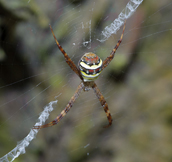
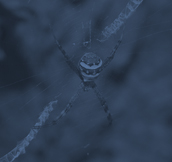 Argiope minuta Araneidae
Argiope minuta Araneidae Main Region: Honshu, Shikoku, Kyushu and Nansei Islands. Found in woods and green spaces from flatlands to mountains. Cephalothorax and legs are brown and the back of abdomen is yellow and brown and white stripe patterns with white spots on brown parts. Is very similar to argiope amoena but the body size of this species smaller as the Japanese name Kogata-koganegumo literally meaning small argiope amoena states. The body size is about the half size of argiope amoena but this only applies for female and male is about the same size. Build an orb web between trees and makes thick thread shaped of a cross of X (sometimes this shape is incomplete). This is called stabilimentum and they place two legs per thread, which allows spiders to blend into the background. Is a timid spider. When sensing dangers, jump off from the web and hide under grass.
Main Region: Honshu, Shikoku, Kyushu and Nansei Islands. Found in woods and green spaces from flatlands to mountains. Cephalothorax and legs are brown and the back of abdomen is yellow and brown and white stripe patterns with white spots on brown parts. Is very similar to argiope amoena but the body size of this species smaller as the Japanese name Kogata-koganegumo literally meaning small argiope amoena states. The body size is about the half size of argiope amoena but this only applies for female and male is about the same size. Build an orb web between trees and makes thick thread shaped of a cross of X (sometimes this shape is incomplete). This is called stabilimentum and they place two legs per thread, which allows spiders to blend into the background. Is a timid spider. When sensing dangers, jump off from the web and hide under grass.
●Length Female about 8 to 12 mm / Male about 4 to 5 mm
●Adults Flight Season July to about October -
Araneus uyemurai Araneidae
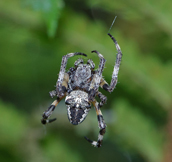
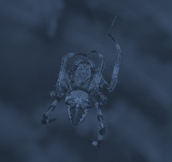 Araneus uyemurai Araneidae
Araneus uyemurai Araneidae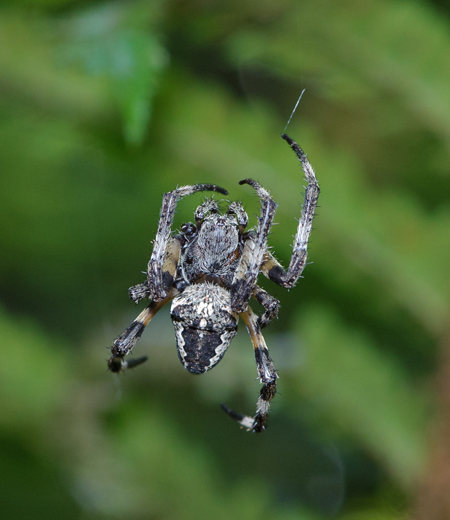 Main Region: Hokkaido, Honshu, Shikoku and Kyushu. Found in woods and green spaces from low elevations to mountains. Body color is dark brown with unique brown and white spots on the back of oval-shaped abdomen with pointed tip. Legs have white and black parts alternating. Is a part of araneus tribe inhabits in mountain areas as the Japanese name Oni-yamagumo literally meaning araneus ventricosus in mountains states. In Mt. Takao, is seen from summer to autumn around forest trails and the areas near forests. Build large orb webs between trees about 2 m width and feed on large insects like cedars. Sometimes is apart from the web and hide on the root of trees or grass under the web.
Main Region: Hokkaido, Honshu, Shikoku and Kyushu. Found in woods and green spaces from low elevations to mountains. Body color is dark brown with unique brown and white spots on the back of oval-shaped abdomen with pointed tip. Legs have white and black parts alternating. Is a part of araneus tribe inhabits in mountain areas as the Japanese name Oni-yamagumo literally meaning araneus ventricosus in mountains states. In Mt. Takao, is seen from summer to autumn around forest trails and the areas near forests. Build large orb webs between trees about 2 m width and feed on large insects like cedars. Sometimes is apart from the web and hide on the root of trees or grass under the web.
●Length Female about 17 to 20mm / Male about 8 to 13 mm
●Adults Flight Season June to about September -
Neoscona mellotteei Araneidae

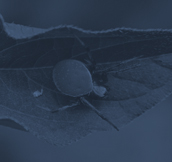 Neoscona mellotteei Araneidae
Neoscona mellotteei Araneidae Main Region: Hokkaido, Honshu, Shikoku, Kyushu and Nansei Islands. Found in forests, green spaces and gardens from flatlands to mountains. The color of back of abdomen is yellow-green and the body shape is oval for male and round for female. A close related species neoscona scylloides which Japanese name is Satsumanomi -damashi literally meaning resembling fruits of toxicodendron succedaneum was named because the body shape resembles the fruits. For this species, the Japanese name Wakiguro-satsumanomi-damashi literally meaning sides of abdomen-black neoscona scylloides because the side of abdomen is dark brown. Build orb web between trees and plants and are active at night. Stay hidden under leaves near the web during daytime.
Main Region: Hokkaido, Honshu, Shikoku, Kyushu and Nansei Islands. Found in forests, green spaces and gardens from flatlands to mountains. The color of back of abdomen is yellow-green and the body shape is oval for male and round for female. A close related species neoscona scylloides which Japanese name is Satsumanomi -damashi literally meaning resembling fruits of toxicodendron succedaneum was named because the body shape resembles the fruits. For this species, the Japanese name Wakiguro-satsumanomi-damashi literally meaning sides of abdomen-black neoscona scylloides because the side of abdomen is dark brown. Build orb web between trees and plants and are active at night. Stay hidden under leaves near the web during daytime.
●Length Female about 7 to 10 mm / Male about 6 to 8 mm
●Adults Flight Season July to about September -
Nephila clavata Nephilidae
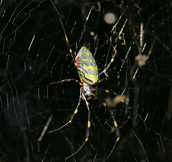
 Nephila clavata Nephilidae
Nephila clavata Nephilidae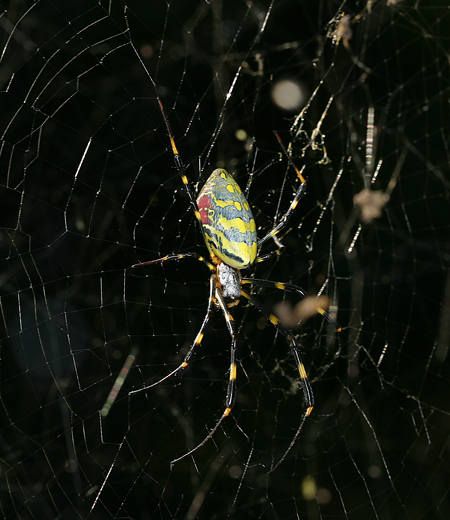 Main Region: Honshu, Shikoku, Kyushu and Nansei Islands. Found in woods and green spaces from flatlands to mountains and also at residential area and parks. Female have yellow and dark blue stripe patterns on abdomen and the tip of abdomen for adults become red. Male is a lot smaller than female and body color is red-brown. With the prominent female body color and the image from the name, it looks like they are poisonous but are not and does not cause damage to human body. Build orb webs between branches. Sometimes the gap between these trees are wide and also spin webs to front and back of the web which one may walk through without noticing. Only female adults build web, thus male visit the web and sometimes some spiders live on the same webs.
Main Region: Honshu, Shikoku, Kyushu and Nansei Islands. Found in woods and green spaces from flatlands to mountains and also at residential area and parks. Female have yellow and dark blue stripe patterns on abdomen and the tip of abdomen for adults become red. Male is a lot smaller than female and body color is red-brown. With the prominent female body color and the image from the name, it looks like they are poisonous but are not and does not cause damage to human body. Build orb webs between branches. Sometimes the gap between these trees are wide and also spin webs to front and back of the web which one may walk through without noticing. Only female adults build web, thus male visit the web and sometimes some spiders live on the same webs.
●Length Female about 20 to 30 mm / Male about 6 to 10 mm
●Adults Flight Season September to about November -
Octonoba sybotides Uloboridae
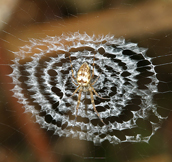
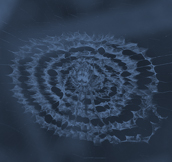 Octonoba sybotides Uloboridae
Octonoba sybotides Uloboridae Main Region: Hokkaido, Honshu, Shikoku and Kyushu. Found in woods and green space from flatlands to mountains and also at parks in cities. Is a small spider about 5 mm and prefer shady woods and underwood. Body color is brown with white spots on abdomen. Is seen from early summer and built slightly tilted orb web between plants. White spiral patterns (stabilimentum) in the center of the web are distinct, helping spiders to blend into the background. This pattern is the origin of the Japanese name of uloboridae family Uzugumo literally meaning spiral spiders.
Main Region: Hokkaido, Honshu, Shikoku and Kyushu. Found in woods and green space from flatlands to mountains and also at parks in cities. Is a small spider about 5 mm and prefer shady woods and underwood. Body color is brown with white spots on abdomen. Is seen from early summer and built slightly tilted orb web between plants. White spiral patterns (stabilimentum) in the center of the web are distinct, helping spiders to blend into the background. This pattern is the origin of the Japanese name of uloboridae family Uzugumo literally meaning spiral spiders.
●Length Female about 4 to 6 mm / Male about 4 to 5 mm
●Adults Flight Season June to about August -
Heteropoda forcipata Sparassidae
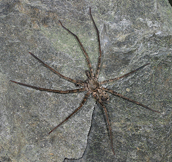
 Heteropoda forcipata Sparassidae
Heteropoda forcipata Sparassidae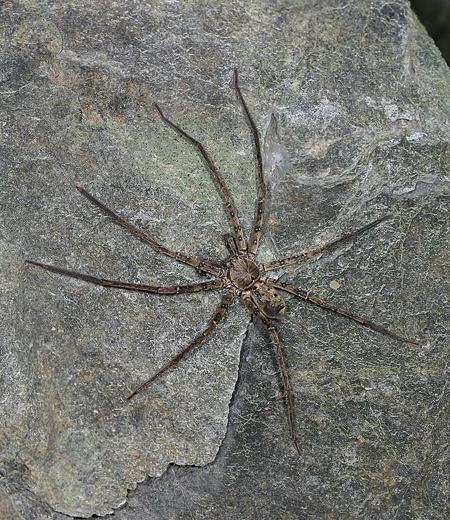 Main Region: Honshu, Shikoku, Kyushu, Sado, Tsushima and Yaku Islands. Found in forests, cliffs and caves from flatlands to mountains. Is one of the large species native to Japan. Body color is brown to dark brown with white or yellow triangular patterns towards the tip of abdomen. Eight legs have some black spots with white center. Similar heteropoda venatoria often inhabit inside of house but this species tends to stay outside. (Sometimes they are inside of house because they hunt insects that are attracted to lights.) During daytime, mostly stay in the splits on barks and shades of rocks and become active at night and hunt moths and cockroaches. Walk to various places and hunt prey without building a web.
Main Region: Honshu, Shikoku, Kyushu, Sado, Tsushima and Yaku Islands. Found in forests, cliffs and caves from flatlands to mountains. Is one of the large species native to Japan. Body color is brown to dark brown with white or yellow triangular patterns towards the tip of abdomen. Eight legs have some black spots with white center. Similar heteropoda venatoria often inhabit inside of house but this species tends to stay outside. (Sometimes they are inside of house because they hunt insects that are attracted to lights.) During daytime, mostly stay in the splits on barks and shades of rocks and become active at night and hunt moths and cockroaches. Walk to various places and hunt prey without building a web.
●Length Female about 20 to 25 mm / Male about 16 to 20 mm
●Adults Flight Season All year -
Dolomedes raptor Pisauridae
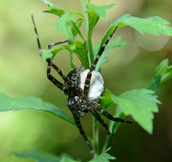
 Dolomedes raptor Pisauridae
Dolomedes raptor Pisauridae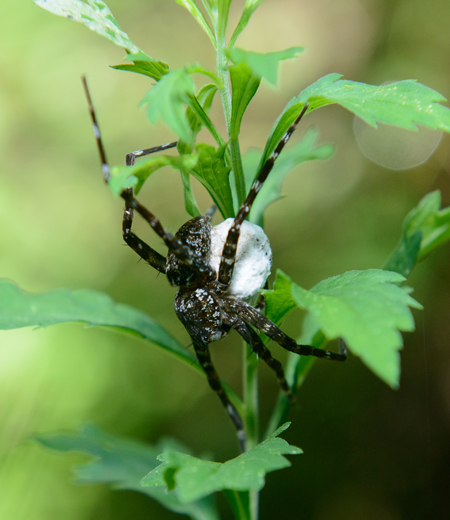 Main Region: Hokkaido, Honshu, Shikoku and Kyushu. Found in forests and grasslands from flatlands to mountains and also in cliffs and paddy fields. Adults female are large in size for spiders native to Japan and body color is bluish dark brown. The tip of abdomen is slightly bright brown with regularly placed white spots. Walk around and hunt insects without building web. Ambush on ground or plants and catch prey as they approaches. Female wrap eggs in round-shaped egg sacs weaved with her threads and carry them around under her abdomen.
Main Region: Hokkaido, Honshu, Shikoku and Kyushu. Found in forests and grasslands from flatlands to mountains and also in cliffs and paddy fields. Adults female are large in size for spiders native to Japan and body color is bluish dark brown. The tip of abdomen is slightly bright brown with regularly placed white spots. Walk around and hunt insects without building web. Ambush on ground or plants and catch prey as they approaches. Female wrap eggs in round-shaped egg sacs weaved with her threads and carry them around under her abdomen.
●Length Female about 22 to 27 mm / Male about 12 to 15 mm
●Adults Flight Season June to about September -
Dolomedes saganus Pisauridae

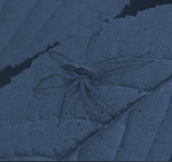 Dolomedes saganus Pisauridae
Dolomedes saganus Pisauridae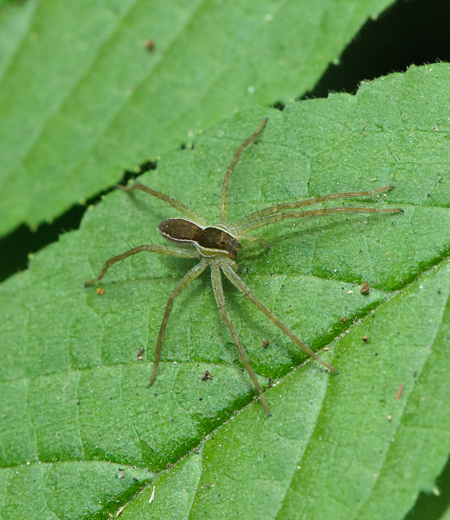 Main Region: Hokkaido, Honshu, Shikoku and Kyushu. Found in forests, woods and green spaces from flatlands to mountains. Body color is red-brown thick strip and white on the sides of the strip from cephalothorax to abdomen as the Japanese name Suji-aka-hashiri-gumo literally meaning strip red pattern spiders states. Normally does not build a web and rest on trees or leaves and ambush insects including horsefly and flies and catch them with quick movement. Female carries ball-shaped egg case with mouthparts. After eggs hatch, build irregularly placed web and take care of baby spiders.
Main Region: Hokkaido, Honshu, Shikoku and Kyushu. Found in forests, woods and green spaces from flatlands to mountains. Body color is red-brown thick strip and white on the sides of the strip from cephalothorax to abdomen as the Japanese name Suji-aka-hashiri-gumo literally meaning strip red pattern spiders states. Normally does not build a web and rest on trees or leaves and ambush insects including horsefly and flies and catch them with quick movement. Female carries ball-shaped egg case with mouthparts. After eggs hatch, build irregularly placed web and take care of baby spiders.
●Length Female about 11 to 15 mm / Male about 10 to 11 mm
●Adults Flight Season July to about October -
Ariamnes cylindrogaster Theridiidae
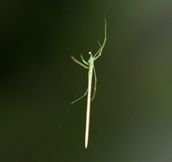
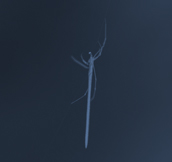 Ariamnes cylindrogaster Theridiidae
Ariamnes cylindrogaster Theridiidae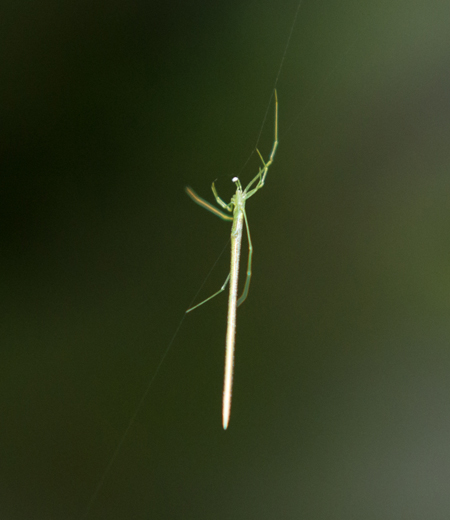 Main Region: Honshu, Shikoku, Kyushu and Nansei Islands. Found in woods and green spaces from low elevations to mountains. Body shape is very different from general spiders as they have skinny and elongated abdomen. Is seen from early spring to summer in satoyama (area that are traditionally where farmlands meets forests) and woods. When legs are extended, the entire body becomes one strait bar that is not easily recognized as spiders. Is often mistaken for stick insects but this species have no segments like they have. There are two types of body colors, green and brown. The behavior is a little different from most of spiders. Build simple web with a couple of threads between branches and immediately prey other spiders that comes to the web.
Main Region: Honshu, Shikoku, Kyushu and Nansei Islands. Found in woods and green spaces from low elevations to mountains. Body shape is very different from general spiders as they have skinny and elongated abdomen. Is seen from early spring to summer in satoyama (area that are traditionally where farmlands meets forests) and woods. When legs are extended, the entire body becomes one strait bar that is not easily recognized as spiders. Is often mistaken for stick insects but this species have no segments like they have. There are two types of body colors, green and brown. The behavior is a little different from most of spiders. Build simple web with a couple of threads between branches and immediately prey other spiders that comes to the web.
●Length Female about 20 to 30mm / Male about 12 to 25 mm
●Adults Flight Season May to about August -
Oxytate striatipes Thomisidae
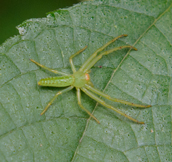
 Oxytate striatipes Thomisidae
Oxytate striatipes Thomisidae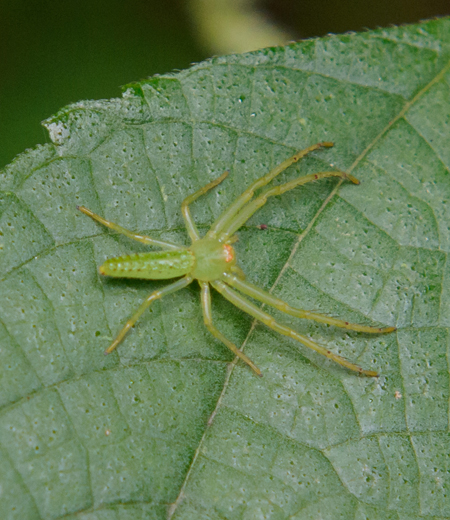 Main Region: Hokkaido, Honshu, Shikoku and Kyushu. Found in woods and green spaces from flatlands to mountains and also found in cities. Body color is bright green like young leaves as the Japanese name Wakaba-gumo literally meaning young leaves spiders states. Is seen from May to June when the season of young leaves. The front part of cephalothorax and the base of legs of Adults male are reddish but the entire body color for female is green. During daytime, ambush on trees or leaves and catch small insects including flies and leaf beetles. The first and second legs from the front are long and remind people of crabs when legs are spread to the sides, hence it is categorized as thomisidae, Kanigumo in Japanese literally meaning crab spiders. Most species in thomisidae have round-shaped abdomen but this species have elongated abdomen.
Main Region: Hokkaido, Honshu, Shikoku and Kyushu. Found in woods and green spaces from flatlands to mountains and also found in cities. Body color is bright green like young leaves as the Japanese name Wakaba-gumo literally meaning young leaves spiders states. Is seen from May to June when the season of young leaves. The front part of cephalothorax and the base of legs of Adults male are reddish but the entire body color for female is green. During daytime, ambush on trees or leaves and catch small insects including flies and leaf beetles. The first and second legs from the front are long and remind people of crabs when legs are spread to the sides, hence it is categorized as thomisidae, Kanigumo in Japanese literally meaning crab spiders. Most species in thomisidae have round-shaped abdomen but this species have elongated abdomen.
●Length Female about 9 to 12 mm / Male about 7 to 11 mm
●Adults Flight Season April to about October -
Carrhotus xanthogramma Salticidae
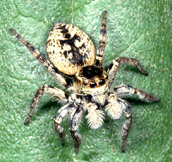
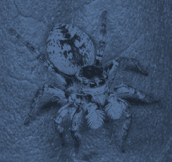 Carrhotus xanthogramma Salticidae
Carrhotus xanthogramma Salticidae Main Region: Hokkaido, Honshu, Shikoku and Kyushu. Found in woods and green space from flatlands to low elevations and also at gardens of residence and parks in cities. Sometimes, come into residence for food. Body length is less than 1mm. Cephalothorax is black and abdomen is brown with black patterns in center for male. Female body is covered by light brown hair. Walk and hunt prey insects on ground and grass and sometimes jump up. Do not build a web but emit thread while walking. This thread is used to hang from the higher place or go back to where they were. The Japanese name Neko-haetori literally meaning cat fly-catcher was named because they catch small insects including flies.
Main Region: Hokkaido, Honshu, Shikoku and Kyushu. Found in woods and green space from flatlands to low elevations and also at gardens of residence and parks in cities. Sometimes, come into residence for food. Body length is less than 1mm. Cephalothorax is black and abdomen is brown with black patterns in center for male. Female body is covered by light brown hair. Walk and hunt prey insects on ground and grass and sometimes jump up. Do not build a web but emit thread while walking. This thread is used to hang from the higher place or go back to where they were. The Japanese name Neko-haetori literally meaning cat fly-catcher was named because they catch small insects including flies.
●Length Both Female and Male about 7 to 8 mm
●Adults Flight Season April to about August -
Myrmarachne japonica(Antmimicking Spider) Salticidae
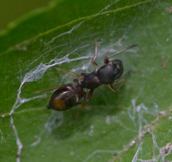
 Myrmarachne japonica(Antmimicking Spider) Salticidae
Myrmarachne japonica(Antmimicking Spider) Salticidae Main Region: Hokkaido, Honshu, Shikoku, Kyushu and Nansei Islands. Found in forests and green spaces from flatlands to mountains. Body color is black-brown or red-brown. The way they move is very similar to ant, hence the other name ant mimicking spider, Arigumo in Japanese. When taking a closer look, ant has three pairs of legs where as this species have four pairs of legs and use first pairs of legs imitates antennae of ant, thus it is difficult to distinguish. Do not build webs and walk to various trees, plants and leaves and hunt small insects. When sensing dangers, jump off from leaves and hide under bushes. The upper jaw of male develops with age and protrudes forward and become more distinct. Female create a room-like space with thread on the back of leaves and lay eggs.
Main Region: Hokkaido, Honshu, Shikoku, Kyushu and Nansei Islands. Found in forests and green spaces from flatlands to mountains. Body color is black-brown or red-brown. The way they move is very similar to ant, hence the other name ant mimicking spider, Arigumo in Japanese. When taking a closer look, ant has three pairs of legs where as this species have four pairs of legs and use first pairs of legs imitates antennae of ant, thus it is difficult to distinguish. Do not build webs and walk to various trees, plants and leaves and hunt small insects. When sensing dangers, jump off from leaves and hide under bushes. The upper jaw of male develops with age and protrudes forward and become more distinct. Female create a room-like space with thread on the back of leaves and lay eggs.
●Length Female about 7 to 8 mm / Male about 5 to 6 mm
●Adults Flight Season June to about August -
Nelima genufusca Sclerosomatidae

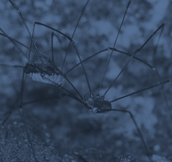 Nelima genufusca Sclerosomatidae
Nelima genufusca Sclerosomatidae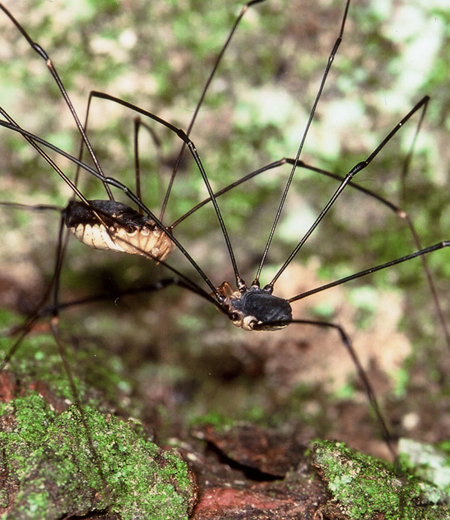 Main Region: Hokkaido, Honshu, Shikoku and Kyushu. Found in woods from low elevations to mountains and are easily found in these environments. The species in opiliones have small body like a bean with disproportional eight long legs. It is often mistaken for a group of spiders but does not have segment between cephalothorax and abdomen (the body looks only have one part) and does not emit thread. Have only two eyes. The body size is larger than palm of adult human being when legs are extended and body color is mostly black except white abdomen part with stripe patterns become more distinct. In Mt. Takao, this species are often found on trees and grass. In late autumn, often seen male and female together or walk slowly on the ground. Feed on small insects and earthworms and fermented fruits with lots of moisture that is fell on the ground.
Main Region: Hokkaido, Honshu, Shikoku and Kyushu. Found in woods from low elevations to mountains and are easily found in these environments. The species in opiliones have small body like a bean with disproportional eight long legs. It is often mistaken for a group of spiders but does not have segment between cephalothorax and abdomen (the body looks only have one part) and does not emit thread. Have only two eyes. The body size is larger than palm of adult human being when legs are extended and body color is mostly black except white abdomen part with stripe patterns become more distinct. In Mt. Takao, this species are often found on trees and grass. In late autumn, often seen male and female together or walk slowly on the ground. Feed on small insects and earthworms and fermented fruits with lots of moisture that is fell on the ground.
●Length about 6 to 12 mm
●Adults Flight Season July to about November -
Gagrellula ferruginea Sclerosomatidae

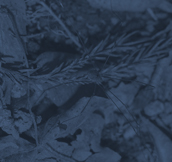 Gagrellula ferruginea Sclerosomatidae
Gagrellula ferruginea Sclerosomatidae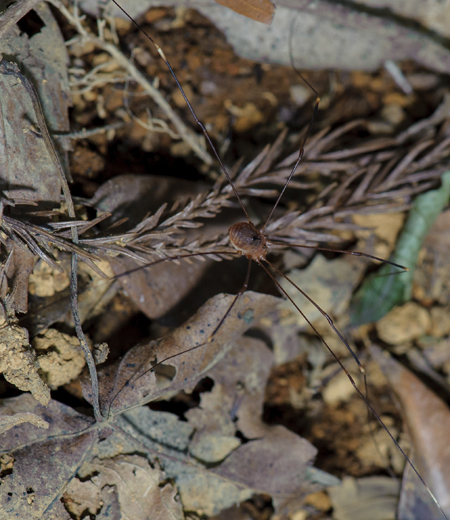 Main Region: Honshu, Shikoku, Kyushu and Yaku Island. Found in forests from low elevations to mountains. Body color varies by region. The ones in Kanto region including Mt. Takao area are so-called Kanto-type are red rust and black on the back with one long needle-like black spine. Adults are seen from July, and often found walking on trees and grass in mid-summer. Another species of opiliones order in Mt. Takao, melanopa grandis roewer also have one spine on the back but the body size is 7 to 10 mm with skinny body with black and legs are thicker and short which is different from this species. For both species, larvae do not have the spine on the back.
Main Region: Honshu, Shikoku, Kyushu and Yaku Island. Found in forests from low elevations to mountains. Body color varies by region. The ones in Kanto region including Mt. Takao area are so-called Kanto-type are red rust and black on the back with one long needle-like black spine. Adults are seen from July, and often found walking on trees and grass in mid-summer. Another species of opiliones order in Mt. Takao, melanopa grandis roewer also have one spine on the back but the body size is 7 to 10 mm with skinny body with black and legs are thicker and short which is different from this species. For both species, larvae do not have the spine on the back.
●Length about 4 to 6 mm
●Adults Flight Season July to about October -
Leiobunum japonicum Sclerosomatidae
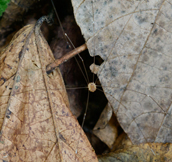
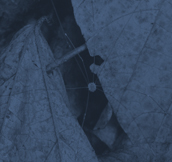 Leiobunum japonicum Sclerosomatidae
Leiobunum japonicum Sclerosomatidae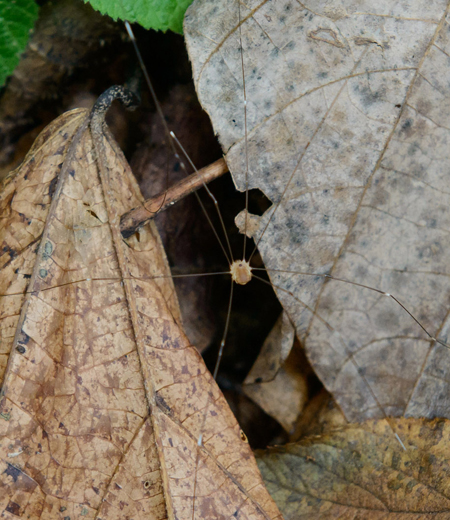 Main Region: Hokkaido, Honshu, Shikoku and Kyushu. Found in forests, tree trunks, grass and bamboo grass areas from flatlands to mountains. Body is slightly-built and bearable in dry environment compare to other species, thus often found in secondary forests including woods. Body shape is round and the color is beautiful yellow-green (Moegi-iro in Japanese) but gradually become light brown with age. Legs are dark-brown and white towards segments. This white part stands out when walking in the shady forests. Some species have one spine on the body. This species, nelima genufusca and gagrellula ferruginea in sclerosomatidae family with long legs appear once a year and eggs laid in soil spend throughout winter in soil. And in spring, larvae come out on ground but they are difficult to find because they are mostly in fallen leave layer. They clime up to trees and grass with age and mountain climbers have more opportunity to find them.
Main Region: Hokkaido, Honshu, Shikoku and Kyushu. Found in forests, tree trunks, grass and bamboo grass areas from flatlands to mountains. Body is slightly-built and bearable in dry environment compare to other species, thus often found in secondary forests including woods. Body shape is round and the color is beautiful yellow-green (Moegi-iro in Japanese) but gradually become light brown with age. Legs are dark-brown and white towards segments. This white part stands out when walking in the shady forests. Some species have one spine on the body. This species, nelima genufusca and gagrellula ferruginea in sclerosomatidae family with long legs appear once a year and eggs laid in soil spend throughout winter in soil. And in spring, larvae come out on ground but they are difficult to find because they are mostly in fallen leave layer. They clime up to trees and grass with age and mountain climbers have more opportunity to find them.
●Length about 3 to 4 mm
●Adults Flight Season August to about November -
Scolopendra subspinipes japonica Scolopendridae

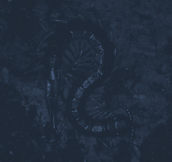 Scolopendra subspinipes japonica Scolopendridae
Scolopendra subspinipes japonica Scolopendridae Main Region: Honshu, Shikoku and Kyushu. Found in shady woods and green spaces from flatlands to mountains and also found around residential areas and sometimes come into houses. Body color is dark-green and head and trunk are almost the same color. Legs are yellow-brown to red and green towards tips. During daytime, mostly hide under the fallen trees, in soils of shady and grassy areas or under fallen leaves and rocks but sometimes rest on leaves or tips of branches. Become active at night and hunt insects including cockroaches and cricket and spiders with sharp fang. Fang is poisonous to human being and skin swell up when bit. Sometimes go under the back when placed on the ground. Female hold eggs under the trunk and protect them until the time larvae are able to hunt independently.
Main Region: Honshu, Shikoku and Kyushu. Found in shady woods and green spaces from flatlands to mountains and also found around residential areas and sometimes come into houses. Body color is dark-green and head and trunk are almost the same color. Legs are yellow-brown to red and green towards tips. During daytime, mostly hide under the fallen trees, in soils of shady and grassy areas or under fallen leaves and rocks but sometimes rest on leaves or tips of branches. Become active at night and hunt insects including cockroaches and cricket and spiders with sharp fang. Fang is poisonous to human being and skin swell up when bit. Sometimes go under the back when placed on the ground. Female hold eggs under the trunk and protect them until the time larvae are able to hunt independently.
●Length about 75 to 100 mm
●Adults Flight Season July to about September -
Hyleoglomeris sp.(Pill Millipedes) Glomeridae

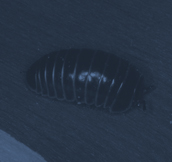 Hyleoglomeris sp.(Pill Millipedes) Glomeridae
Hyleoglomeris sp.(Pill Millipedes) Glomeridae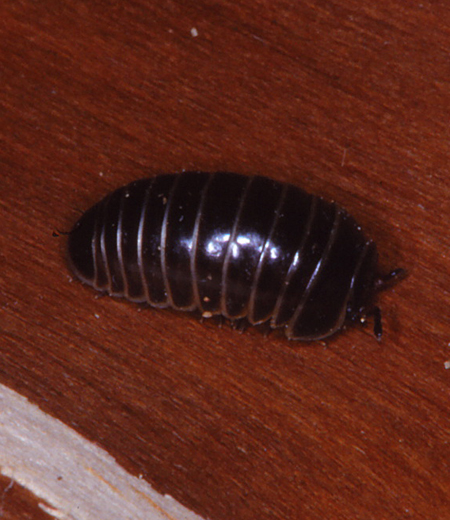 Main Region: Honshu, Shikoku and Kyushu. Found in shady woods and green spaces from flatlands to mountains. Is a part of diplopoda family prefers wet environment such as under fallen trees or fallen leaves and also in woody parks and shrine ground even in cities but they are not well-known and often mistaken for wood louse. Body color is shiny black-brown and white on segment, creating stripe patterns. When attacked by enemies, curl into a ball with head hidden and become complete round-shape as the Japanese name of wood louse, dango-mushi literally meaning ball-shaped insects states. The species curl into a ball, wood louse is widely known but wood louse does not hide their head when curled. This species have two paired legs with four legs per segment. In Mt. Takao, often found in areas where fallen leaves sediment on forest floor and feed on decaying plants in leaf soil.
Main Region: Honshu, Shikoku and Kyushu. Found in shady woods and green spaces from flatlands to mountains. Is a part of diplopoda family prefers wet environment such as under fallen trees or fallen leaves and also in woody parks and shrine ground even in cities but they are not well-known and often mistaken for wood louse. Body color is shiny black-brown and white on segment, creating stripe patterns. When attacked by enemies, curl into a ball with head hidden and become complete round-shape as the Japanese name of wood louse, dango-mushi literally meaning ball-shaped insects states. The species curl into a ball, wood louse is widely known but wood louse does not hide their head when curled. This species have two paired legs with four legs per segment. In Mt. Takao, often found in areas where fallen leaves sediment on forest floor and feed on decaying plants in leaf soil.
●Length about 7 to 8 mm
●Adults Flight Season March to about November -
Geothelphusa dehaani (Japanese Freshwater Crab) Potamidae

 Geothelphusa dehaani (Japanese Freshwater Crab) Potamidae
Geothelphusa dehaani (Japanese Freshwater Crab) Potamidae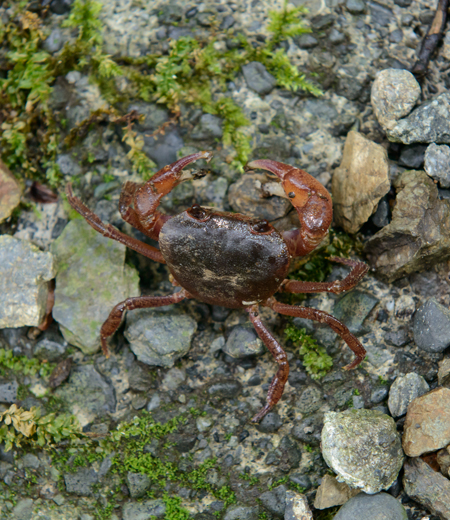 Main Region: Honshu, Shikoku, Kyushu, Sado Island, Oki Island, Tanega Island and Yaku Island. Found in valleys, mountain streams, swamps with many rocks and fallen leaves from low elevations to mountains. Is freshwater crabs prefer clear water from upstream to midstream and stay mostly under grabbles and fallen trees in water. Body color varies to three types, purple-black, red-brown and gray-blue varies by region. The found in Mt. Takao is brown shell with dark-yellow cheliped. Is mostly active at night but sometimes seen on mountain trails during daytime on rainy or cloudy days. Is an omnivore and feed on small insects, snails, earthworms and plants or fallen leaves on waterside. Female lays 50 eggs and hold them on abdomen to protect until they hatch. When it becomes closer to winter, hide under rocks in water and spend winter.
Main Region: Honshu, Shikoku, Kyushu, Sado Island, Oki Island, Tanega Island and Yaku Island. Found in valleys, mountain streams, swamps with many rocks and fallen leaves from low elevations to mountains. Is freshwater crabs prefer clear water from upstream to midstream and stay mostly under grabbles and fallen trees in water. Body color varies to three types, purple-black, red-brown and gray-blue varies by region. The found in Mt. Takao is brown shell with dark-yellow cheliped. Is mostly active at night but sometimes seen on mountain trails during daytime on rainy or cloudy days. Is an omnivore and feed on small insects, snails, earthworms and plants or fallen leaves on waterside. Female lays 50 eggs and hold them on abdomen to protect until they hatch. When it becomes closer to winter, hide under rocks in water and spend winter.
●Length about 20 to 30 mm (Width of shell)
●Adults Flight Season March to about November -
Orobdella octonaria Orobdellidae
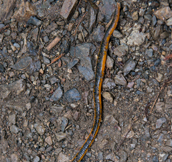
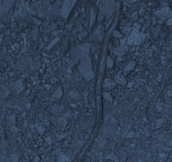 Orobdella octonaria Orobdellidae
Orobdella octonaria Orobdellidae Main Region: Honshu. Found in forests near waterside from flatlands to mountains. It a group of ground leeches becomes larger than 40 cm when the body is stretched. The Japanese name Yatsuwa-kuga-biru, kuga is an old word for ground and yatsuwa means the surface of segments are divided into eight parts that look like wrinkles on the back. Body color varies by region but the species found in Mt. Takao is orangey yellow with black patterns in the center of the back. Prefer wet environment and often found under rocks along waterside and fallen leaves. When the ground is wet on rainy day, comes out on forest trails and often freaks mountain climbers. Is a predator and mainly feed on earthworms and swallow whole earthworms that are larger than own body size. Unlike general leeches, this species is not harmful as they do not suck blood.
Main Region: Honshu. Found in forests near waterside from flatlands to mountains. It a group of ground leeches becomes larger than 40 cm when the body is stretched. The Japanese name Yatsuwa-kuga-biru, kuga is an old word for ground and yatsuwa means the surface of segments are divided into eight parts that look like wrinkles on the back. Body color varies by region but the species found in Mt. Takao is orangey yellow with black patterns in the center of the back. Prefer wet environment and often found under rocks along waterside and fallen leaves. When the ground is wet on rainy day, comes out on forest trails and often freaks mountain climbers. Is a predator and mainly feed on earthworms and swallow whole earthworms that are larger than own body size. Unlike general leeches, this species is not harmful as they do not suck blood.
●Length about 10 to 40 cm
●Adults Flight Season All year
